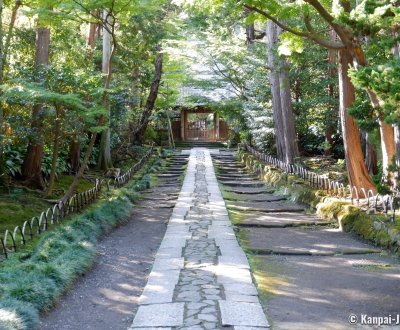Daibutsu Hiking Trail
The Hills in Western Kamakura
Daibutsu Hiking Trail connects Jochi-ji temple, near Kita-Kamakura station, to the Kotoku-in, in western Kamakura Hase’s neighborhood. The forest trail winds through the hills while giving access to several lesser known temples and shrines in a tranquil atmosphere, far from the seaside’s touristic crowd.
In addition to its historical heritage as the former shogunal capital of Japan from 1185 to 1333, Kamakura enjoys an ideal topography. While a seaside resort on the shore of the Sagami Bay with a view on the Pacific Ocean, the city’s landward side is surrounded by a succession of forestry hills providing a very little urbanized natural setting that it is pleasant to tread.
3 hiking courses in the forest offer an original way of discovering Kamakura and connect many spiritual sites with various degrees of attendance. These trails allow to move away from the tourists crowd who focuses in the main shopping streets at the center of the city, for more serenity and spirituality.
Provided you are in good health, the walk is accessible to all, regardless of the age. You will actually encounter many elderly Japanese hikers who usually greet all the walkers on their way, a nice way to ensure that every body is doing good. However, make sure to wear good walking shoes and to pack water, snacks, a Pocket Wi-Fi to be reachable and a mosquito repellent in summer.
On the western heights of the city, the Daibutsu course is connecting Jochi-ji temple near Kita-Kamakura station to Kotoku-in, the temple famous for its sitting great Buddha. The 2,5 kilometers long marked footpath can be finished in 1h30 without hurry. It was rendered impracticable after typhoon 🌀 Hagibis hit in 2019, but it reopened on June 2020. The Gionyama Trail, in the eastern hills, on the other end, is still closed at the end of 2022, more than 3 years after the disaster. Furthermore, we strongly recommend not to use Kamakura walking trails on the days following strong rains ☔️ as the slippery and muddy ground could be dangerous.
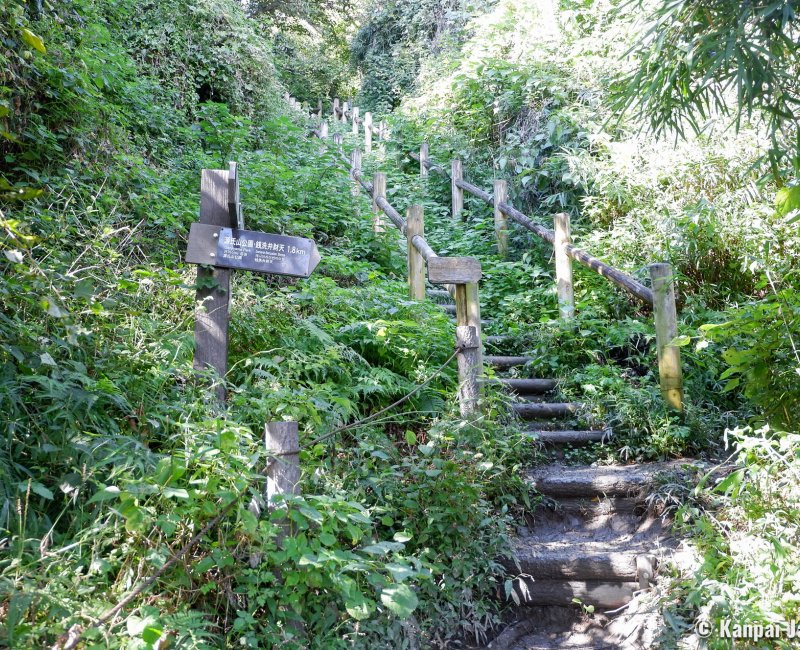
A trail riding the heights of Kamakura
The Daibutsu Hiking Course starts after the visit of Kotoku-in, along the road 32 at the level of the Former Daibutsuzaka Gymnasium, abandoned in 2002 and under scaffolding as of summer 2022. Find the tunnel and the narrow stairway on its side that quickly climbs to the heights. In only a few minutes times, you will find yourself surrounded by trees, amidst nature, and far from the city’s noises.
Wood logs or large stones steps help overcome the steep areas. In summer, the narrow walking path is entangled by the Joro spiders’s big webs. The Trichonephila clavata spider, unknown in Europe, is characterized by its long legs and vivid colors, with the female displaying a yellow and black stripe pattern. The Joro spider is rather shy and only tries to protect its territory. Its bites are not dangerous to the human, unless in case of a specific allergy.
The earthen path then separates in several forks leading to various small temples and shrines nestled in the forest. A handful of signs written in Japanese, in English and in Korean are here to help keeping on the trail. In the highest part of the Daibutsu Trail, a view between the trees allows to observe the roofs of the city and the beaches 🏖 of the Shonan coast, up to the neighboring seaside resort Zushi at the entrance of the Miura peninsula.
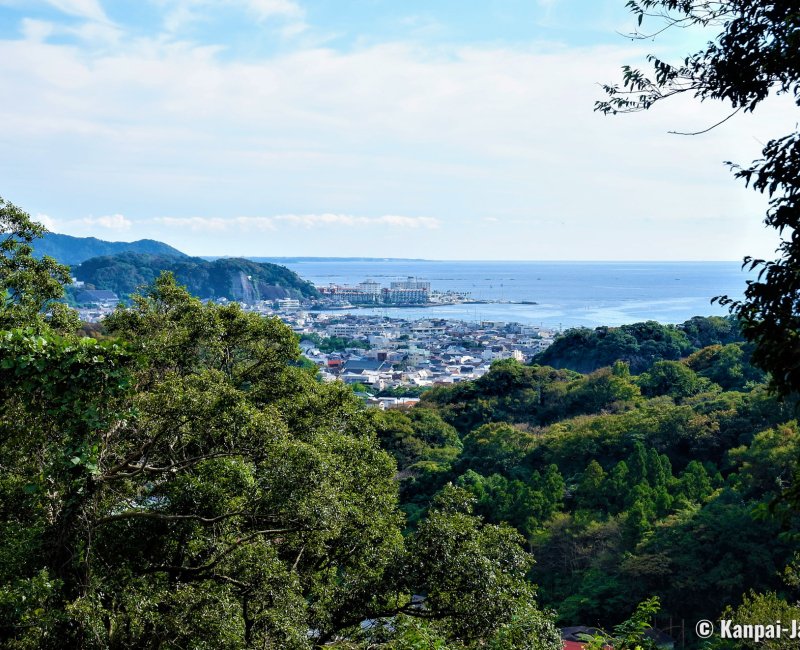
Small temples and shrines hidden in the forest
Below is a brief review of the spiritual or historical sites that can be visited along the Daibutsu Hiking Trail.
Kuzuharaoka-jinja
Founded in 1887 at the demand of Emperor Meiji (1867 - 1912), Kuzuharaoka-jinja is dedicated to Hino Toshimoto, a noble who became, after his death in 1332, the kami deity of luck and learning, thanks to his important actions that marked the history of Japan. He was a scholar, retainer of Emperor Go-Daigo (1288 – 1339) and actively took part in the fall 🍁 of the Kamakura shogunate, for which he was later executed for treason.
Surrounded by the forest, the entrance of the shrine is marked by a tall stone torii ⛩️ gate, as well as by a sacred rock called Masaru Ishi 魔去る石 at which one must strongly throw a plate (to purchase 100¥ (~US$0.65)) and break it, in an attempt to ward off evil spirits and bring good luck. The buildings are simple and discreet; are noteworthy the grave of Hino Toshimoto, a warehouse for a mikoshi portable shrine and the main hall honden.
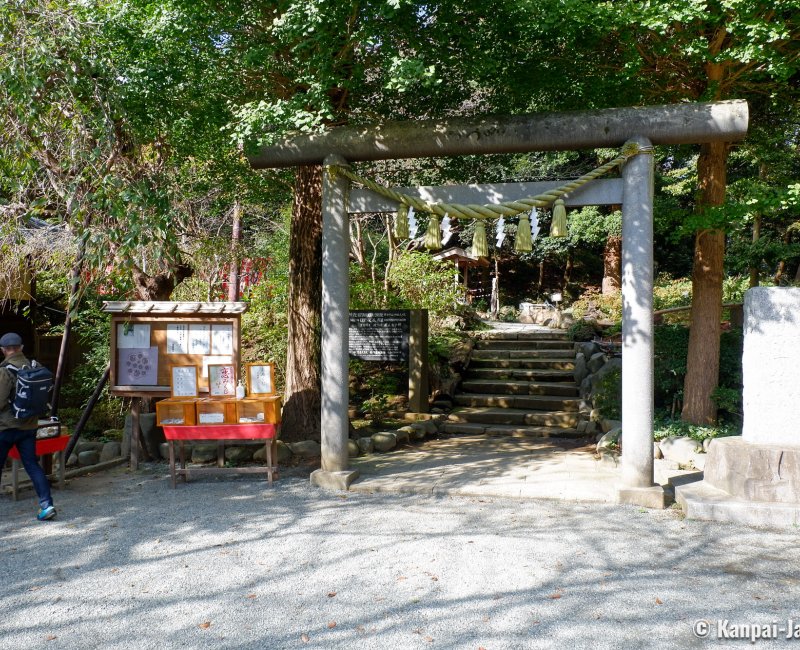
Genjiyama Park
In the continuation of Kuzuharaoka shrine, Genjiyama Koen spreads in an enjoyable 9,5 hectares green space arranged for promenade. It was inaugurated in 1965 to commemorate the visit of the founder of the Kamakura shogunate Minamoto no Yoritomo (1147 – 1199) in 1185. The quietness of the park is seldom troubled; in the beginning of spring, the local gather under the blooming cherry trees 🌸 to celebrate ohanami.
Zeniarai Benten and Sasuke Inari-jinja
Then, the path reaches 2 rather unusual shrines, which are consequently more popular. Dedicated to Benzaiten, one of the 7 Lucky Gods in Japan, Zeniarai Benten is the perfect example of a successful syncretism between Buddhism and Shinto. Visitors can wash coins in the sacred source to make a wish of fortune.
Sasuke Inari-jinja is a kawaii shrine, that is to say "cute". A collection of fox statuettes, the divine messengers of kami Inari, is indeed scattered throughout the spiritual enclosure engulfed in the forest.
Jufuku-ji
As the course nearing its end, one of the fork leads to Jufuku-ji temple, after the crossing of a Buddhist cemetery. The later oozes a mystical aura and it especially shelters tombs in yagura caves, such as the grave of Hojo Masako (1157 – 1225), Minamoto no Yoritomo’s spouse, and of their son Minamoto no Sanetomo (1192 - 1219).
Established in 1200, Jufuku-ji is dedicated to the historical Buddha Shaka Nyorai and to the shogun Minamoto no Yoritomo. It is the oldest Zen temple in Kamakura and belongs to the Rinzai sect, like the great Kencho-ji. The temple was built at the exact location of Yorimoto’s father’s former residence under the direction of master Zen Eisai (1141 – 1215). The Chumon intermediary gate leads to the Butsuden pavilion, closed to the public, and that was last reconstructed in 1664.
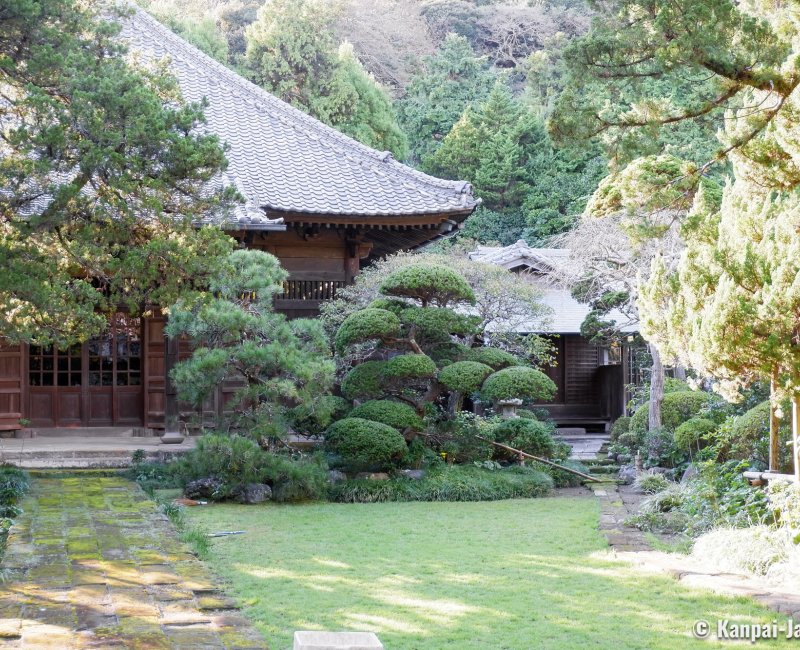
From Jufuku-ji temple, a few minutes only easy walk leads to Jochi-ji and Kita Kamakura JR station, the starting point to discover the great Zen temples in the north of the city.

